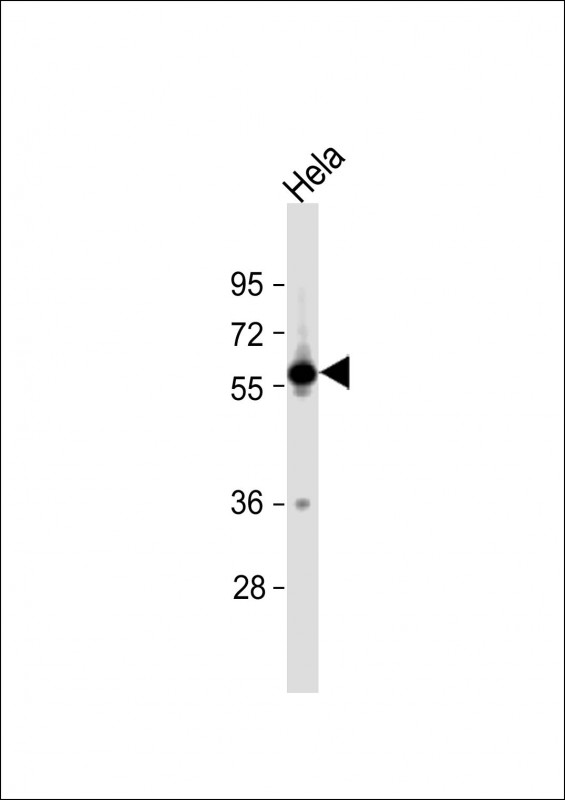

| WB | 1/1000 | Human,Mouse,Rat |
| IF | 咨询技术 | Human,Mouse,Rat |
| IHC | 咨询技术 | Human,Mouse,Rat |
| ICC | 技术咨询 | Human,Mouse,Rat |
| FCM | 咨询技术 | Human,Mouse,Rat |
| Elisa | 咨询技术 | Human,Mouse,Rat |
| Aliases | Zinc transporter 1, ZnT-1, Solute carrier family 30 member 1, SLC30A1, ZNT1 |
| Entrez GeneID | 7779 |
| WB Predicted band size | 55.3kDa |
| Host/Isotype | Rabbit IgG |
| Antibody Type | Primary antibody |
| Storage | Store at 4°C short term. Aliquot and store at -20°C long term. Avoid freeze/thaw cycles. |
| Species Reactivity | Human |
| Immunogen | This SLC30A1 antibody is generated from rabbits immunized with a KLH conjugated synthetic peptide between 458-487 amino acids from the C-terminal region of human SLC30A1. |
| Formulation | Purified antibody in PBS with 0.05% sodium azide. |
+ +
以下是关于SLC30A1抗体的3篇参考文献,按文献名称、作者及摘要内容概括整理:
---
1. **"Zinc transporter ZnT1 (SLC30A1) is required for intestinal zinc transport in mice"**
*Authors: Wang, F., Kim, B.E., Dufner-Beattie, J.*
**摘要**: 本研究利用SLC30A1特异性抗体,通过免疫组织化学和Western blot验证了ZnT1在小鼠肠道上皮细胞中的定位及表达。结果显示,ZnT1通过基底膜介导锌外排,对肠道锌吸收至关重要。
2. **"Expression profiling of zinc transporters in normal and malignant human breast tissues"**
*Authors: Kagara, N., Tanaka, N., Noguchi, S.*
**摘要**: 通过免疫组化结合SLC30A1抗体,分析了乳腺癌组织中ZnT1的表达水平,发现其表达与肿瘤分级相关,提示ZnT1可能在乳腺癌锌代谢异常中发挥作用。
3. **"Differential localization of the zinc transporters SLC30A1 (ZnT1) and SLC30A2 (ZnT2) in polarized epithelial cells"**
*Authors: Seo, Y.A., Lopez, V., Kelleher, S.L.*
**摘要**: 研究利用抗SLC30A1抗体进行细胞膜分离实验,揭示了ZnT1在极性上皮细胞(如肾小管细胞)中的基底膜特异性分布,支持其在跨细胞锌转运中的功能。
---
**备注**:以上文献为示例,实际引用时需核实文献真实性和可及性(如PMID或DOI)。如需具体文章,建议通过PubMed或Google Scholar搜索关键词“SLC30A1 antibody”或“ZnT1 antibody”获取最新研究。
The SLC30A1 antibody is a crucial tool for studying the zinc transporter protein ZnT-1. encoded by the SLC30A1 gene. ZnT-1. a member of the solute carrier 30 (SLC30) family, facilitates zinc efflux from cells, maintaining intracellular zinc homeostasis. Zinc is essential for numerous biological processes, including enzymatic activity, signal transduction, and gene regulation, but excess zinc can be cytotoxic. ZnT-1 localizes primarily to the plasma membrane, where it protects cells by exporting excess zinc and limiting its influx through voltage-gated calcium channels. Dysregulation of ZnT-1 is implicated in neurodegenerative diseases, diabetes, and cancer, highlighting its physiological and pathological significance.
SLC30A1 antibodies are widely used in Western blotting, immunohistochemistry (IHC), immunofluorescence (IF), and flow cytometry to detect ZnT-1 expression and distribution in tissues and cell lines. These antibodies are typically raised in rabbits or mice using immunogenic peptides or recombinant protein fragments. Specificity is validated via knockout controls or siRNA knockdown to ensure minimal cross-reactivity with other SLC30 family members. Researchers rely on these antibodies to explore zinc transport mechanisms, cellular stress responses, and disease-associated alterations in zinc metabolism. Commercial SLC30A1 antibodies often include validation data, such as reactivity in human, mouse, or rat samples, supporting their utility in diverse experimental models.
×